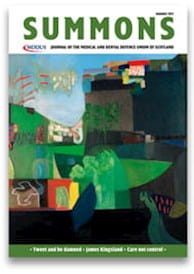DUTCH doctor and physiologist Willem Einthoven may be well known for inventing the first practical electrocardiogram but it was a British cardiologist who pioneered its use in the clinical setting.
Thomas Lewis spent his early years in Wales where his father was a mining engineer. Except for one year at Clifton College, Bristol, he was educated at home. He had freedom to explore the countryside and became a keen observer of birds.
After a first degree (BSc with Honours) from University College, Wales, he was attracted to medicine (he claimed it was because of the skills of two doctors who were magicians) and chose University College, London. Soon he had published his first paper on the haemolymphatic glands and spleen, a part of a DSc (Wales 1905). He was invited to work in Professor E H Starling’s laboratory at University College. Posts at the City of London Hospital and the Seaman’s Hospital gave him some income, supplemented by a practice in Wimpole Street.
He was encouraged to study irregular heart action by Dr James Mackenzie who, after years observing patients in general practice, was doing research at Mount Vernon (a hospital purchased by the Medical Research Council). Lewis also sought the help of the pioneer of electrocardiography William Einthoven in Leyden. The electrical wave forms were carefully analysed and correlated with heart actions. Lewis was one of the first to characterise the appearance of human atrial fibrillation and most other cardiac disrhythmias. Years later, when Einthoven was awarded a Nobel prize he acknowledged the contribution Lewis had made.
In 1910 Lewis was made lecturer in cardiac pathology at University College Hospital, a new red brick building opposite University College. He visited America and physicians from there spent time in his laboratory. Lewis set high standards of diligence from his students and was a fierce editor. He was somewhat taciturn, blue eyed with an intense gaze, a moustache and a receding hairline.
Apart from long hours in the laboratory and teaching Lewis spent time writing. He founded and edited the journal Heart and over the rest of his life wrote books, too many to list here, which illustrate how his interests changed. In each field he made important contributions to medicine. His first book, in 1909, was Mechanism and registration of the heart beat. His Diseases of the heart (1933) was very popular. The soldier’s heart and the effort syndrome (1918) described the effects of stress on soldiers.
Post war he was appointed Physician in Charge of the Cardiology Department funded by the MRC. He found laboratory research was too limited and in a letter to the Morning Post he wrote about the lack of access to observe patients in hospital. His interests and thoughts turned to the reaction of skin to injury. He described the triple response of red line, flare and weal and hypothesised that a substance was released in the skin. Following discussion with Henry Dale, the pharmacologist, he thought a compound similar to histamine was likely and named it substance H.
From 1922 he sought to understand the mechanism of muscle pain and nerve paralysis during ischaemia. His co-worker George Pickering described how he tackled the problem – “using no apparatus more complicated than a blood pressure cuff and a tuning fork...This was Lewis at his best, the Lewis who gave up cardiology because he grew tired of answering the kind of questions the instruments could answer and longed for adventures suggested by his own mind.” He postulated a metabolite ‘factor P’ was the trigger for pain and muscular ischaemia and identified the mechanism of Raynaud’s disease. Not all his theories were believed. In 1937 his hypothesis that a ‘nocifensor system’ of nerves in the skin was the cause of hyperalgesia was only validated a half century later when he was no longer alive.
Another war loomed and Lewis gave aid to German Jewish scientists who had emigrated. When war came UCL evacuated the medical school to Wales and put Lewis in charge with the help of his devoted assistant, John Honour.
During the second world war Pain was published in the USA. His last book, published in the year of his death, was Exercises in Physiology. He also made films: The signs of venous congestion and with Henry Dale, a vivid recreation of the experiments of William Harvey.
Aged only 45 he had suffered a first heart attack but was reluctant to believe the diagnosis; a third myocardial infarction in 1945 was fatal. He received many honours including the University of London Gold Medal, CBE, Knight Bachelor for his work in WW1, the Copley Medal of the Royal Society. Prestigious lectures included the Harveian Oration on Clinical Science in 1933. He married in 1916 and had three children. He had helped to revolutionise cardiology and increase medical understanding. Diagnoses like ‘rebellious palpitations’ had vanished.
Source: Thomas Lewis: Pioneer Cardiologist and Clinical Scientist by A Hollman, Springer 1997
Julia Merrick is a freelance writer and editor in Edinburg
This page was correct at the time of publication. Any guidance is intended as general guidance for members only. If you are a member and need specific advice relating to your own circumstances, please contact one of our advisers.
Read more from this issue of Insight

Save this article
Save this article to a list of favourite articles which members can access in their account.
Save to library